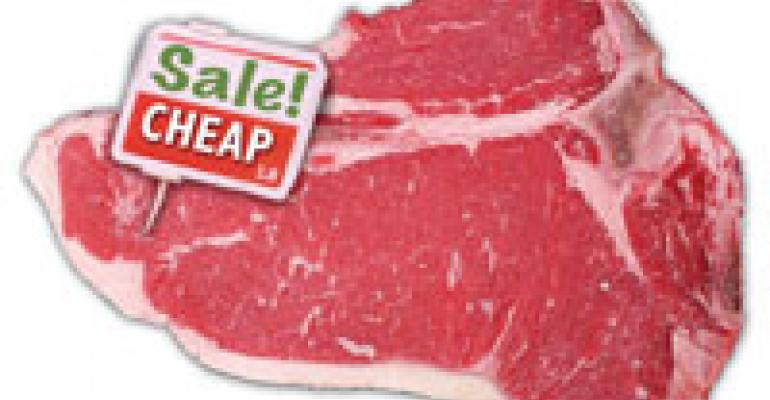CENTENNIAL Colo. The prices of some premium cuts of beef have fallen to their lowest levels in years as demand for those cuts has slowed, allowing restaurateurs to expand their steak selections and offer them at better prices to cash-strapped consumers.
According to CattleFax, a Centennial-based market analyst firm for the cattle and beef industry, the wholesale prices for some Choice rib cuts and strip loin subprimals in February were at the lowest they had been since 2002. In addition, an increase in the amount of USDA Choice-grade meat available also has put downward pressure on prices.
CattleFax’s vice president of business development, Mike Miller, said beef in general is less expensive than it has been since prices began to spike in 2006.
Choice prices in particular are down partly because recession-embattled customers have been trading down in quality, he said, and partly because the cattle industry has responded to the reduction in beef demand with a reduction in production.
“Any time that happens, we tend to have the cattle be a little older [when they go to market],” Miller said, and more mature cattle tend to have better marbling and so more of the meat qualifies as Choice grade.
Choice is the second highest grade of beef in the U.S. Department of Agriculture system. Top-notch Prime only accounts for about 3 percent of all beef, according to the USDA.
In contrast to premium beef, demand for ground beef remains robust, and so does its price.
“Particularly at retail, we’ve seen some consumers trading down from higher-priced cuts to ground beef,” Miller said, noting that demand for hamburger meat has been “excellent” for the past 12 to 18 months.
Enson Wong, chef of Redline Food + Drink in Cambridge, Mass., said he has not seen a universal drop in beef prices.
“I think it depends on who you’re buying from and what quality you’re using,” he said.
Miller said he expects prices for more premium grades of beef to stay relatively low for another six months or more, but he added that prices would start to rise somewhat in the springtime, when beef production traditionally slows down for supply-related reasons. Namely, most cattle are born in the spring and are sent to market when they’re slightly older than a year, resulting in a shortage of beef ready for market in early spring.
Miller said beef prices also would likely rise more in the late spring and summer, when demand goes up starting with Mother's Day and continuing through summer because of grill-heavy holidays such as Memorial Day, Father’s Day, Independence Day and Labor Day.
In the meantime, some restaurants are making use of the low prices to sell more beef.
Jeff Muldrow, chef-owner of Va Pensiero Restaurant in Evanston, Ill., said he saw the prices of the Angus beef that he buys start to fall a few months ago.
“We buy primal cuts — whole tenderloins and sirloins — and I have not seen these prices on those cuts of meat in about four years,” he said. But cheaper Angus cuts such as those from the shoulder “are still pretty expensive,” he said.
As a result, Muldrow has added a wider variety of steaks to his menu, including a Porterhouse for two, carved at tableside, for $48.
“Last year we would have had to add $12 or $14 to that price,” he said, and that would have priced it out of his customers’ comfort zone.
Contact Bret Thorn at [email protected].

